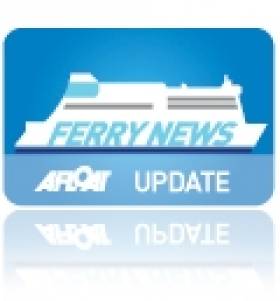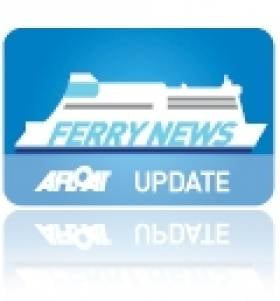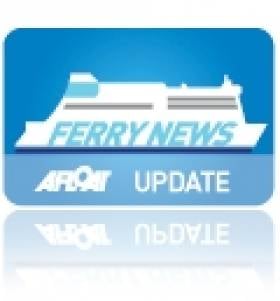Displaying items by tag: Stena Navigator
Stena Sale Ferry to Spanish Operator
#FERRY NEWS- Stena Navigator which served on the former Belfast-Stranraer route, has been sold to overseas buyers. She was one of three ferries made redundant following the switch pf ports to a new ferry terminal in Cairnryan and introduction of larger vessels, writes Jehan Ashmore.
Having only been introduced on the North Channel in late 2009, Stena Navigator (PHOTO) is now set to embark on a new career in the Mediterranean with Spanish operator Baleària. The company operates routes linking the islands to the Spanish mainland in addition to the Strait of Gibraltar, where the ferry is to start service.
The 1,650-passenger, 280-vehicle capacity vessel is currently berthed at Albert Quay, Belfast, before she makes her delivery voyage.
Launched in 1984 as Champs Elysees at Dubigeon Normandie, Nantes Saint Nazaire, for SNCF's Dover-Calais route. She then spent service Stena Line as Stena Parisien between Newhaven-Dieppe before been sold to SeaFrance. This saw her return to the Dover Strait as SeaFrance Manet until eventually sold back to Stena Line.
Berthed ahead of the 15,229grt ferry is her former fleetmate Stena Caledonia, built at the nearby Harland & Wolff and upriver the HSS Stena Voyager is berthed at VT4 Terminal. Since been laid-up the vessels were transferred to a Stena subsidiary, Northern Marine Management (NMM).
Historic Days on North Channel Ferry Routes
#FERRY NEWS- In the space of two days, Stena Line opened a new ferry route between Belfast-Cairnryan today following yesterday's closure of services between Belfast-Stranraer, writes Jehan Ashmore.
Sisters Stena Superfast VII and Stena Superfast VIII inaugurated sailings on the 2 hour 15 minute with 12 crossings daily, and in which will use a new £80m ferry terminal at Loch Ryan Port, Cairnryan and the VT4 terminal in Belfast. The relocation of Scottish ports and terminal investment cost £200m.
The newcomers have a capacity for 1,200 passenger /660 vehicles or 110 freight units. They received a refit and upgrade in Poland where new luxurious facilities such as a Nordic Spa, interactive lounge zone with the latest in technology and free Wi-Fi access throughout the vessel and VIP lounges were installed. To read more click HERE.
At 204m and over 30,000 tonnes each the German built pair are easily the largest ever ferries to operate in the North Channel and will compete with rivals P&O Larne-Cairnryan route served by the 20,000 tonnes sisters European Causeway and European Highlander both built in Japan.
The introduction of the former Scandinavian serving sisters directly replaced Stena Caledonia and HSS Stena Voyager from the Belfast-Stranraer route which only started in 1995. Prior to then Stena Line had operated a service from Larne, which could trace ferry services for the last 123 years.
The Swedish ferry company decided to abandon the route in favour of Belfast. This development also saw the introduction of the second revolutionary HSS 1500 series catamaran ferry HSS Stena Voyager in tandem with various conventional tonnage used over the last sixteen years. The final sailings at the weekend marked the closure of nearly 140 years of several ferry operators running between Stranraer at the end of Loch Ryan and Belfast.
With the withdrawal of HSS Stena Voyager and Stena Caledonia yesterday, she joins former fleetmate Stena Navigator in Belfast, which stood down from Stranraer service last week as previously reported, to read click HERE.
Stena Superfast VII Departs Poland for New Belfast-Cairnryan Route

The New Superfast leaves Gdansk
The 30,285grt newcomer and her sister Stena Superfast VIII will become the largest ever ferries running on the North Channel , though prior to entering service on 21 November, they will undertake berthing trials and crew training.
For the next two-years the sisters are on charter from Scandinavian operators Tallink, and are to operate the new 2 hour 15 minute route with 12 crossings daily. The ten-deck ships can carry up to 1200 passengers, 660 cars or 110 freight units. The sisters will be re-gistered in their new homport of Belfast.
The relocation of Scottish ferry port and the introduction of the Superfast sisters will replace the existing pair of conventional ferry tonnage, Stena Caledonia and Stena Navigator (1984/15,229gt) the latter vessel is believed to be sold. In addition HSS sailings will cease causing the HSS Stena Voyager to become redundant, she was the second of the trio of pioneering HSS 1500 craft built.
When Stena Superfast VII departed Gdansk, she passed the Stena Vision which operates Stena Line's Karlskrona-Gdynia route, the Baltic Sea city lies to the west of Gdansk. Also in Gdansk was the Stena Feronia, the former Irish Sea serving Visentini built ro-pax Dublin Seaways, which was operated albeit briefly by DFDS Seaways last year on the Dublin-(Birkenhead) Liverpool service.
She served under her new Scandinavian owners but the firm's first foray into the Irish market lasted a mere six months. DFDS Seaways sold their Irish Sea network to Stena Line (to read report click HERE) with the exception of their Dublin-Birkenhead service which closed. In addition the Dublin-Heysham freight-only route which closed until re-opened by Seatruck Ferries. The route is currently served by Anglia Seaways, the freightferry which DFDS previously used on the route is on charter to the operator.
- DFDS Seaways
- Baltic Sea
- Stena Line
- Ports and Shipping News
- Seatruck Ferries
- North Channel
- Stranraer
- Dublin Seaways
- Ferry news
- Tallink
- Loch Ryan Port
- HSS Stena Voyager
- Stena Caledonia
- Stena Navigator
- Belfast Lough News
- HSS
- Visentini ropax
- BelfastCairnryan
- Stena Superfast VII
- Stena Superfast VIII
- Stena Superfast
- Superfast Sisters
- North Channel ferry routes
- Stena Feronia
- LRP
- BirkenheadBelfast
- DublinBirkenhead
Award Winning Stena Line Look Forward to New Northern Route
"We are moving into a very important time for Stena Line's operation between Northern Ireland and Scotland. On November 21 we are scheduled to start our new Belfast to Cairnryan service which will also see the introduction of two new vessels, Stena Superfast VII and Superfast VIII, the largest ships every to have sailed between Northern Ireland and Scotland," he continued.
Stena Line's switch of Scottish terminal from Stranrear to the new purpose built facility in Cairnryan which is some 8-miles closer to the open sea along Loch Ryan will reduce sailing times by 35 minutes down to 2 hours 15 minutes.
The 30,285grt Stena Superfast VII and Superfast VIII sisters can carry 1,200 passengers, 660 cars and 110 freight-unit / trucks. In addition they have a novel Nordic Spa facility incorporating a sauna and Jacuzzi.
The 206m pair will compete with rivals P&O (Irish Sea) which operates also from a neighbouring terminal in Cairnryan where another pair of sisters European Highlander and European Causeway provide 2-hour sailings to Larne.
Currently Belfast-Stranraer sailings are served by conventional tonnage ferries Stena Caledonia and Stena Navigator which lost engine-power on 14 October, to read more click HERE.
In addition fast-sailings are run by the expensive to operate HSS Stena Voyager which manages a faster crossing time on the existing route by shaving 15 minutes off the link between Loch Ryan and Belfast Lough. In 2008 the terminal in Belfast was relocated downriver to Victoria Terminal 4 (VT4) on the eastern edge of the port from the older inner-city terminal at Albert Quay.
Stena are to lease the 'Superfast' pair for three years from Scandinavia operator Tallink and they are to directly replace both the HSS and conventional ferries.
Stranraer-Belfast Ferry Left Adrift Off Scottish Coast
The Press Association reports that the Stena Navigator was en route from Stranraer to Belfast when both of its engines broke down.
The ferry - carrying 70 passengers and 47 crew - was adrift some four nautical miles west of Corsewall Point lighthouse at the Mull of Galloway.
Clyde Coastguard confirmed that two Svitzer tugs, Norton Cross and Willowgarth, were dispatched to the vessel with the aim of towing it to Belfast, but the ferry managed to get one enging going and propelled itself at half power across the North Channel.
The Navigator arrived in port accompanied by the tugs around 4:30am. No injuries were reported in the incident.
Family Fun Day Cruise’s from Belfast
The 'cruise' onboard the ferry Stena Navigator (for virtual tour click HERE) is based on a return excursion on the North Channel route.
So what's included?...there's live music, disco / karaoke, face-painting, balloon modeling and party games for the children. For further family entertainment there's even a magician, Wii-games, free movies and free Wi-Fi.
In addition a 10% discount is available from the onboard shop, though exclusions apply.
Cruises are not catered for vehicles but apply to 'foot' passengers, for further details on terms and conditions, cruise itinerary and travel dates click HERE.
Superfast Sisterships for Stena's Northern Route
Stena will lease the ferries for a three year period from Tallink, the Baltic Sea based shipping group. (Click here for photo of Superfast VIII in ice-flow waters). The charter arrangement includes an option to extend for a further year.
The distance between the new ferry terminal named the 'Loch Ryan Port' at Old House Point (which is just north of Cairnryan) is approx. 8kms apart from Stranraer taking the coastal (A77) road along the Loch that leads onto to Glasgow. At Cairnryan, rivals P&O (Irish Sea) who along with predecessing operators have run services on the route to Larne for several decades.
With a speed of 27-knots, passage times on the new Stena Belfast-Cairnryan route will take 2 hours 15 minutes, this compares to the existing time of 2 hours 50 minutes from Stranraer by conventional ferry and 2 hours taken by the HSS fast-ferry.
As a consequence of Stena operating from Loch Ryan Port, passage times by the Superfast sisters will be reduced by 35 minutes as the Belfast terminal was also relocated in recent years. Though despite the relocated ferry terminals, the Superfast sisters scheduled 2 hours 15 minutes sailings from the new port will be slightly longer compared to the HSS Stena Voyager's 2 hour sailing time from Stranraer.
Also serving the Belfast Stranraer route are the conventional ferries, Stena Caledonia (formerly Sealink's St. David built at Harland & Wolff) and Stena Navigator, that served SeaFrance on Dover-Calais sailings as SeaFrance Manet. When the Superfast sisters replace the HSS Stena Explorer and the conventional ferries, perhaps there will be a new a role for the two vessels in replacing expensive to run fast-craft operated elsewhere.
In the meantime the Superfast pair will maintain running on Tallink's 26-hour Helsinki-Rostock until mid-August. The 2001 German will then undergo an extensive refit of passenger facilities and a new freight-only deck will be incorporated to cater for haulage operators increasing use of higher vehicles and double-deck freight units.
The 'Superfast' vessel naming theme derives from the original owners, Greek operator Superfast Ferries, which sold their Scandinavian operations to Tallink in 2006.






























































